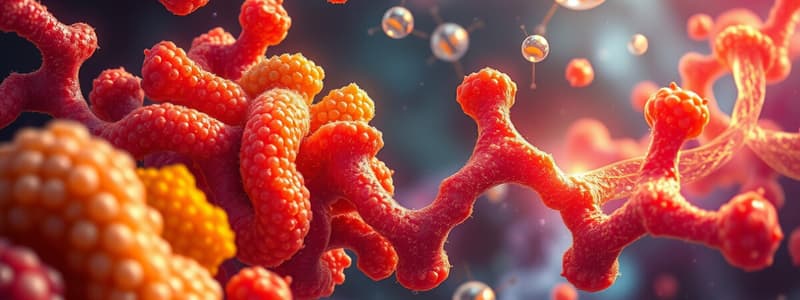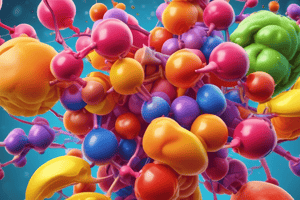Podcast
Questions and Answers
What is the main function of carbohydrates in our bodies?
What is the main function of carbohydrates in our bodies?
Carbohydrates are the body's ideal fuel for most functions. They give glucose to fuel our cells and supply the body with the energy needed for the muscles, brain, and central nervous system.
What types of food can we eat to obtain carbohydrates?
What types of food can we eat to obtain carbohydrates?
Fruits, vegetables, beans, dairy products, foods made from grain products, sugar, honey, molasses, and corn syrup.
What are the 3 types of carbohydrates? Explain each one and give an example of food you can eat that contains each type.
What are the 3 types of carbohydrates? Explain each one and give an example of food you can eat that contains each type.
The three types are simple, complex, and indigestible. Simple carbohydrates are made up of one or two sugar units, such as a lollipop. Complex carbohydrates consist of many sugar units, like starch found in potatoes. Indigestible carbohydrates, like fiber in prunes, cannot be broken down for energy.
Why can low-carb diets be harmful to your body? Explain.
Why can low-carb diets be harmful to your body? Explain.
What are lipids? What substances are considered to be lipids?
What are lipids? What substances are considered to be lipids?
What are steroids? What can they do to you and for you?
What are steroids? What can they do to you and for you?
What is a triglyceride? What are the two parts that make up a triglyceride?
What is a triglyceride? What are the two parts that make up a triglyceride?
What are saturated fats? Give an example.
What are saturated fats? Give an example.
What are unsaturated fats?
What are unsaturated fats?
What are trans fats and how are they made?
What are trans fats and how are they made?
Why are trans fats bad for you?
Why are trans fats bad for you?
What is HDL?
What is HDL?
What is LDL?
What is LDL?
What do trans fats do to the levels of each?
What do trans fats do to the levels of each?
What are proteins made up of?
What are proteins made up of?
What is the difference between complete and incomplete proteins? Give an example of each.
What is the difference between complete and incomplete proteins? Give an example of each.
What is YOUR recommended daily allowance of protein based on the chart?
What is YOUR recommended daily allowance of protein based on the chart?
What is the function of nucleic acids?
What is the function of nucleic acids?
Name the 2 major types of nucleic acids.
Name the 2 major types of nucleic acids.
What is the specific name for the building blocks of nucleic acids?
What is the specific name for the building blocks of nucleic acids?
Flashcards are hidden until you start studying
Study Notes
Carbohydrates
- Primary source of energy for body functions, fueling cells, muscles, brain, and central nervous system.
- Sources include fruits, vegetables, beans, dairy products, grain products, sugar, honey, molasses, and corn syrup.
- Three types of carbohydrates:
- Simple: Composed of one or two sugar units, quickly digested (e.g., lollipop).
- Complex: Made of many sugar units, takes longer to digest (e.g., potatoes).
- Indigestible: Fiber that cannot be absorbed for energy (e.g., prunes).
- Low-carb diets can lead to weakness due to insufficient energy supply.
Lipids
- Organic molecules containing carbon, with notable forms including oils and earwax.
- Steroids are a type of lipid, functioning in hormones, muscle enhancement, and medical applications (e.g., acne treatment, muscle relaxants).
- Triglycerides consist of glycerol and fatty acids, acting as a form of fat.
Fats
- Saturated fats: Contain single bonds, often referred to as "bad" fats (e.g., butter, high-fat milk).
- Unsaturated fats: Have double bonds, considered "good" fats (e.g., olive oil, fish oil, walnuts).
- Trans fats: Created by hydrogenating unsaturated fats, converting liquid to solid, linked to health risks.
- Trans fats increase LDL (bad cholesterol) and decrease HDL (good cholesterol), elevating the risk of heart disease and strokes.
Cholesterol
- HDL (High-Density Lipoprotein) is beneficial cholesterol.
- LDL (Low-Density Lipoprotein) is harmful cholesterol, typically associated with increased health risks.
Proteins
- Composed of amino acids, with 20 different types existing.
- Complete proteins contain essential amino acids and are found in animal products (e.g., meat, fish, eggs, milk).
- Incomplete proteins lack one or more essential amino acids (e.g., rice).
- Recommended daily protein intake for 9-13 year-olds is 34 grams.
Nucleic Acids
- Serve as the genetic material in living organisms, forming the building blocks of life.
- Two main types: Deoxyribonucleic Acid (DNA) and Ribonucleic Acid (RNA).
- Nucleotides are the specific building blocks of nucleic acids.
Studying That Suits You
Use AI to generate personalized quizzes and flashcards to suit your learning preferences.




